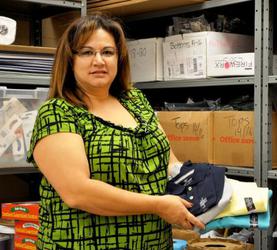A child living with friends, a couple and their two children sharing a single room in a family member’s house or a family living out of a car. All these scenarios qualify a child as homeless, a situation that is on the rise in Maricopa.
In the past four years the number of homeless children attending school in the Maricopa Unified School District has doubled from about 100 to 200 children.
Typically, these children are not homeless in the sense they are living on the streets according to MUSD homeless assistance liaison Micki Schroeder. Instead, they are kids whose living situations have been massively disrupted.
“We try to help these children as required by law in the McKinney-Vento act,” Schroeder said.
The McKinney-Vento Homeless Assistance Act states that children who are homeless have the right to attend their home school, or the community school they last attended, as well as receive other assistance.
“For example, we have one child who lives in a motel in Casa Grande who is bused into Maricopa,” Schroeder said. The program mandates school districts cooperate with each other on logistics, sharing the expenses of transporting children.
“This program brings some stability to the lives of children who are living in a state of upheaval,” Schroeder said. In addition to keeping children in stable educational environments, the legislation requires schools to provide children with free lunches, school supplies and uniforms.
The act provides money to districts to offset these costs, but school districts sometimes offer additional help that goes above and beyond the minimum requirements.
“This act provides just the bare essentials,” Schroeder said. “We try to do more. Right now, for example, we are trying to get money together to buy winter jackets for these children.”
The increase in homelessness and a lack of resources to deal with the problem are not confined to Maricopa, according to Robert Herrera, emergency services case manager for the Community Action Human Resources Agency, an Eloy-based nonprofit that helps families in need.
“We are seeing a swell of displaced families across the county,” he said.
Herrera said many families are not aware of the availability of federal assistance, but he strongly encourages clients to take advantage of it. “I have seen this program improve the quality of life for many children in difficult situations,” he said “Keeping these kids in the same school really does wonders.”
How to help
MUSD’s Homeless Education Program is seeking donations of solid-colored zip or button-front jackets for distribution to local homeless students.
Jackets are needed for ages 4 to 18. Donations should be new or gently used and may be sent to school with a student to give to the school secretary, or dropped off at the district office between 8 a.m. and 4 p.m. through Nov. 30. For more information, contact Schroeder at Schroeder at 520-568-5100 ext. 1035.




![Maricopa sheds tears amid Maui wildfires that killed dozens For Maricopa resident Janelle Gomez, the sorrow mirrors the loss of a family member. [Brian Petersheim]](https://www.inmaricopa.com/wp-content/uploads/2023/08/Gomez-218x150.jpg)
![Embracing Freedom: Celebrating the Fourth of July Councilmember Vincent Manfredi at Great American 4th 2021 [Victor Moreno]](https://www.inmaricopa.com/wp-content/uploads/2023/07/2021-Great-American-4th-e1688414543522-218x150.jpg)












